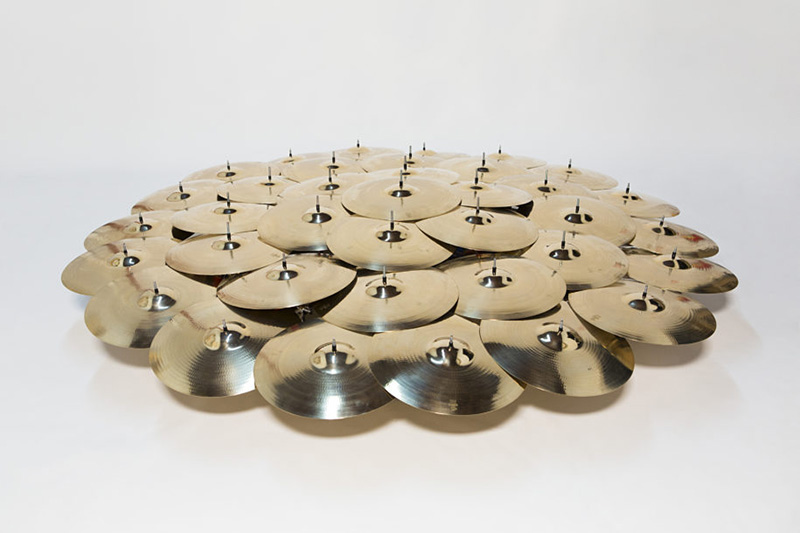ART CITIES:N.York-Terry Adkins
 Terry Adkins created sculptures that were “as ephemeral and transient as music” and fashioned mixed-media artworks that relied on visual as well as sonic activation. He worked in depth on a research-based series, termed “Recitals,” which bore tribute to historical figures, those that history had overlooked or misunderstood. As Adkins reintroduced his subjects, he also called into question the processes by which people are classified and their pasts become or not, a part of history.
Terry Adkins created sculptures that were “as ephemeral and transient as music” and fashioned mixed-media artworks that relied on visual as well as sonic activation. He worked in depth on a research-based series, termed “Recitals,” which bore tribute to historical figures, those that history had overlooked or misunderstood. As Adkins reintroduced his subjects, he also called into question the processes by which people are classified and their pasts become or not, a part of history.
By Dimitris Lempesis
Photo: Lévy Gorvy Gallery Archive
The exhibition “The Smooth, The Cut, and The Assembled” focuses on the formal methods he employed to distill his art down to the very “essence” of his materials, often mining the history of the African diaspora for marginalized forms and figures. Born in 1953 in Washington D.C, Adkins grew up in a musical household (his mother was an amateur pianist and clarinetist, and his father played organ and sang in the church choir)in Alexandria. Music also played a critical role in his work, for which he earned a BS from Fisk University in 1975, an MS from Illinois State University in 1977, and an MFA from the University of Kentucky in 1979. Adkins emerged in the mid-1980s, when he began reconstructing instruments from weighty and weathered found and fabricated materials, such as textiles, farm tools, leather straps, and shipping ropes. Yet, he resisted the art historical term “found object”, which he believed did not pay enough respect to the materials or his process. Adkins preferred the term “Potential disclosure” to describe his creative use of salvaged materials. While on residency at the BINZ39 Foundation in Zürich, Adkins formed the performance collective Lone Wolf Recital Corps, a rotating ensemble of artists, musicians, and friends. Upon returning to New York in 1988, his experience with the Corps reinforced new connections between his sculptural and musical pursuits. The exhibition includes two Untitled works which accompanied his performance “Buffet Flat” (2008-09), the blown-glass figurines, reunited for the first time, are identical except for their discordant surface texture and hue. No longer accessories to a theatrical set, these amorphous shapes acquire an aura of their own, frozen in anticipation of musical accompaniment. Adkins researched groundbreaking historical figures such as John Brown, Matthew Henson, or Bessie Smith-whose legacies were in danger of being forgotten. A jazz musician who played the saxophone, he created a vast body of work that included sculptures, photographs, videos, prints, installations, and performances. Adkins said, “I try to make sculpture that is as ephemeral and transient as music is…And when it comes to working with sound…I try to make it more of a physical thing, so that embedded in the sculpture is the trace of sound, the trace of the nature of sound.” Works classified as “assembled” demonstrate the intricate hybridity of the artist’s sculptures and the layered complexity of the historical figures to whom he pays homage. “Darkwater Record” (2003–8), a stack of five Nakamichi 550 cassette decks topped with a porcelain bust of Mao Zedong, plays W.E.B. Du Bois’* famous speech, “Socialism and the American Negro” (1960), in a continuous loop. The sculpture lacks speakers, however, and the viewer cannot hear a word, the sound is represented by the erratic dials on the decks, jumping at each tone in Du Bois’s voice.
* William Edward Burghardt Du Bois, (born February 23/21868-27/8/1963), sociologist, historian, author, editor, and activist who was the most important black protest leader in the United States during the first half of the 20th century. He shared in the creation of the National Association for the Advancement of Colored People (NAACP) in 1909 and edited The Crisis, its magazine, from 1910 to 1934. His collection of essays “The Souls of Black Folk” (1903) is a landmark of African American literature.
Info: Curator: Charles Gaines, Lévy Gorvy Gallery, 909 Madison Avenue, New York, Duration: 10/1-17/2/18, Days & Hours: Tue-Sat 10:00-18:00, www.levygorvy.com

